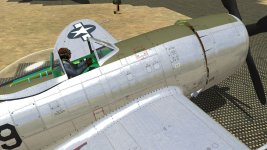My method is working with layers in a paint program; separate layers for the rivets, panel lines, squadron codes/stencils, paint job, weathering etc. This gives good control over the appearance, opacity, intensity etc. of each layer and makes it possible to use the same basic layout to create multiple textures for the same 3D model. So once all rivets, panel lines and other basics are painted on their respective layers, you essentially have a paint template. Now it is possible to create multiple 'skins' by only changing (repainting) the necessary layers (squadron codes, colours, weathering etc) without having to redo the rivets, panel lines etc. The order and opacity of the respective layers will make the rivets 'show through' - if that answers your question.
A complex texture template can have dozens of layers and that's just the main texture (_t.dds). The specular/reflective texture (_r.dds / _s.dds) is derived from this template and is basically an adjusted greyscale version of the _t.dds texture where lighter means more specular/reflective and darker gives a more matte/dull effect. Again, having items on separate layers gives better control over the final result. Then you could create a winter version of your skin (_w.dds, to depict your model in winter camo or as a dirtier/muddier version of the _t.dds texture to reflect winter conditions in the theater of operations of your choice). And finally, with the use of Ankor's shaders, there's also a bump (or normal) map to create which adds surface detail effects through game engine's environmental lighting (eg. skin buckling, panel thickness differences, material texture etc.). Texture-wise, I should not forget the .mos file, which is used to display effects like bullet holes and other damage effects. That all is a lot of work! (And that is why it takes so long to finish this project. Learning 3D modelling on the fly doesn't help either

).
There are some very good painters frequenting this forum but IMHO the absolute master of the trade is Bravo/4. If you have specific questions about painting that I don't know the answer to, he might be the go-to person.

 ).
).


 Beautifully detailed, a treat to the eye!
Beautifully detailed, a treat to the eye!